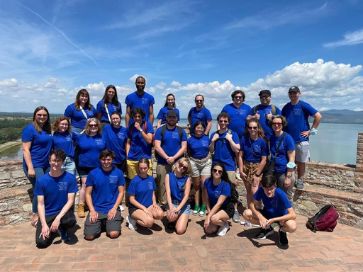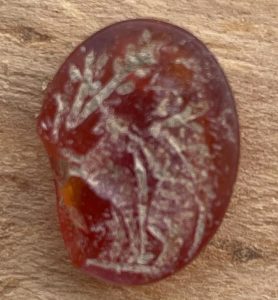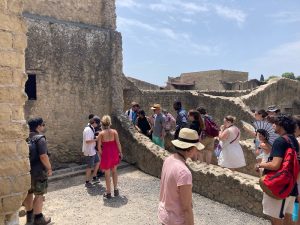Exploring Archaeology in Italy

Each summer, students opt to explore archaeology in Italy through the Umbra Institute’s Summer Archaeology Field School. The program is unique in how it blends in-class learning with field experience and the exploration of sites across Italy.
About the Dig Site

This year, the field school began digging at a new site near Castiglione del Lago. While it was expected that the site would hold answers to the region’s questions about its Roman history, it was not expected that the site would so quickly begin to offer its insight! Within days of starting the dig, students found an old Roman coin and an ancient amber intaglio (pictured to the left).
About the Courses on Archaeology in Italy
 Being in Italy gives Field School participants plenty of hands-on experiences. This is true even beyond the dig site as while students take ARCH/CLAS 325: Archaeology in Central Italy: the Etruscan and Roman Heritage, they get the opportunity to explore unique archaeological sites such as Pompeii. Last weekend, the cohort visited Pompeii where they received an in-depth tour with their professors. They discussed the history of the old city and aspects of its culture revealed by archaeologists over the years. In addition to Pompeii, the group also visited Ercolano and Oplontis, as well as Napoli’s archaeological museum.
Being in Italy gives Field School participants plenty of hands-on experiences. This is true even beyond the dig site as while students take ARCH/CLAS 325: Archaeology in Central Italy: the Etruscan and Roman Heritage, they get the opportunity to explore unique archaeological sites such as Pompeii. Last weekend, the cohort visited Pompeii where they received an in-depth tour with their professors. They discussed the history of the old city and aspects of its culture revealed by archaeologists over the years. In addition to Pompeii, the group also visited Ercolano and Oplontis, as well as Napoli’s archaeological museum.
Other sites that this summer’s students have visited include Perugia’s Archaeology Museum and the 1416 festival during which they saw Etruscan artifacts and discussed Roman conquest; a visit to Assisi and Spello where they learned about Roman society; and a tour of Trasimeno and Isola Maggiore where they learned about the Battle of Trasimeno.
Would you like to learn more about the Field School?
Click here to read more about the program with the Umbra Institute and check out the program-specific WordPress site that includes a student blog and details about community outreach.